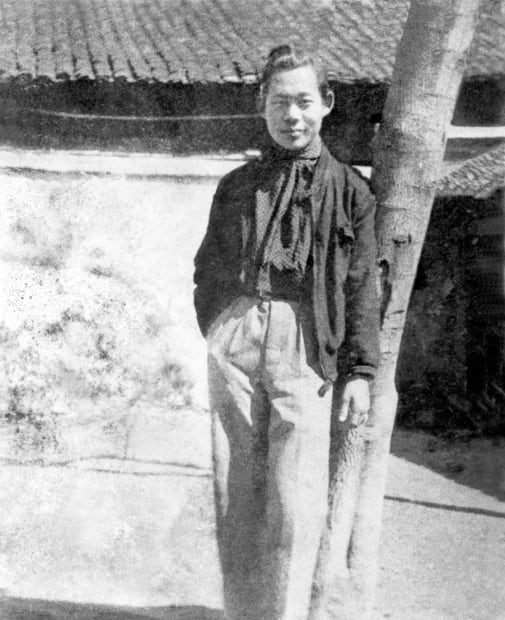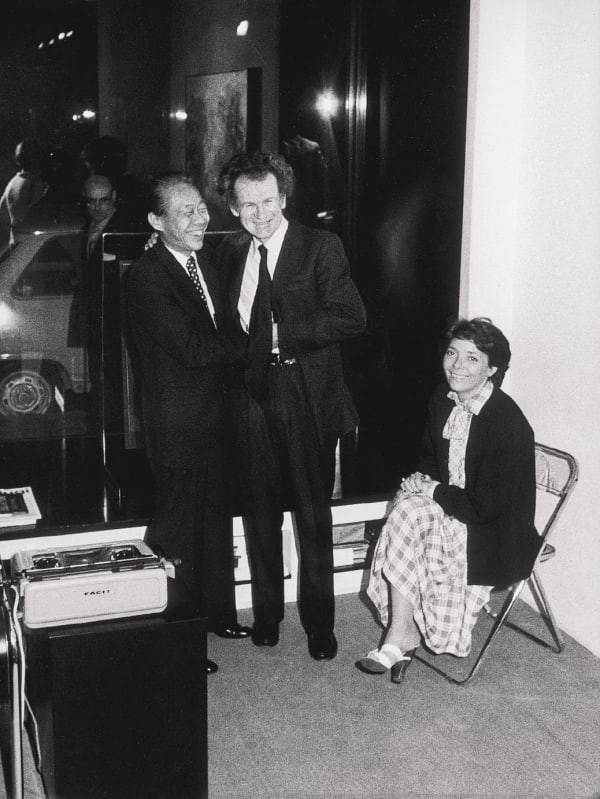-
 Zao Wou-Ki in his Paris studio in 1958. Rights Reserved.
Zao Wou-Ki in his Paris studio in 1958. Rights Reserved.The Story of Zao Wou-Ki
Zao Wou-Ki (Chinese/French, 1920–2013), born in Beijing, China, was an internationally-renowned Abstract artist. His role in the Lyrical Abstraction circle of postwar painters in France represented a juncture of Chinese and postwar European and American painting traditions.
-
 Zao Wou-Ki circa 1920. Rights reserved.
Zao Wou-Ki circa 1920. Rights reserved. -
-
 Zao Wou-Ki circa 1935, at Hangzhou School of Fine Arts. Rights reserved.
Zao Wou-Ki circa 1935, at Hangzhou School of Fine Arts. Rights reserved. -
-
 Zao Wou-Ki with his sisters in Hangzhou circa 1946. Rights reserved.
Zao Wou-Ki with his sisters in Hangzhou circa 1946. Rights reserved. -
 Zao Wou-Ki (third from right) with his whole family at the port of Shanghai, before leaving for France, February 26, 1948. Rights reserved.
Zao Wou-Ki (third from right) with his whole family at the port of Shanghai, before leaving for France, February 26, 1948. Rights reserved. -
 Zao Wou-Ki in Paris in 1948. Rights reserved.
Zao Wou-Ki in Paris in 1948. Rights reserved. -
-
 With Jean-Paul Riopelle in Zao Wou-Ki’s studio, in front of Foudre, 1956. Rights reserved.
With Jean-Paul Riopelle in Zao Wou-Ki’s studio, in front of Foudre, 1956. Rights reserved. -
-
 In his Paris studio with 29.09.64 and an early version of 21.09.64, around 1964. Photo Budd
In his Paris studio with 29.09.64 and an early version of 21.09.64, around 1964. Photo Budd -
-
 Zao Wou-Ki in his Paris studio, 1973. Photo Mohror
Zao Wou-Ki in his Paris studio, 1973. Photo Mohror -
In 1977, Fourteen paintings, most of them in large-scale, were shown at the Fuji Television Gallery in Tokyo, including Hommage à André Malraux (Homage to André Malraux) (200 x 525 cm). Thanks to its director, Susumu Yamamoto, works entered several of the most important Japanese collections, including the Hakone Museum and the Ishibashi Foundation. Zao Wou-Ki and Françoise Marquet married in July.
Zao Wou-Ki donated work to the Bibliothèque nationale de France in 1978, completing a series of etchings already kept by the Cabinet des Estampes. The donation was presented to the public the following year. In 1979, New York art dealer Pierre Matisse visited his studio and offered to show paintings and drawings at his gallery. After not showing work in the city for 15 years, the project was of major importance for Zao Wou-Ki.
-
 Painting with China ink in his Paris studio, 1981. Photo Serge Lansac.
Painting with China ink in his Paris studio, 1981. Photo Serge Lansac. -
 In class at Hangzhou School of Fine Arts, 1985. Rights reserved.
In class at Hangzhou School of Fine Arts, 1985. Rights reserved. -
-
 Portrait, 1997. Photo Chou
Portrait, 1997. Photo Chou -
 Exhibition opening in Shanghai, November 4, 1998. Rights reserved.
Exhibition opening in Shanghai, November 4, 1998. Rights reserved. -
 At the Galerie Nationale du Jeu de Paume with his triptych Mai-septembre 89 during the presentation of the ceremonial sword of the Académie Française, November 26, 2003. Photo Dennis Bouchard
At the Galerie Nationale du Jeu de Paume with his triptych Mai-septembre 89 during the presentation of the ceremonial sword of the Académie Française, November 26, 2003. Photo Dennis Bouchard -
 With Dominique de Villepin at Hôtel Matignon, 2005. Rights reserved.
With Dominique de Villepin at Hôtel Matignon, 2005. Rights reserved. -
-
 At the Prieuré de Saint-Cosme in Tours, with his stained glass windows in front of the pulpit, July 2010. Photo Philippe Koutouzis
At the Prieuré de Saint-Cosme in Tours, with his stained glass windows in front of the pulpit, July 2010. Photo Philippe Koutouzis -
Coutesy Fondation Zao Wou-Ki
-
 1995. Zao Wou-Ki in his Paris studio. Reserved rights. Photo Credit: Hervé Pasquet
1995. Zao Wou-Ki in his Paris studio. Reserved rights. Photo Credit: Hervé Pasquet


















